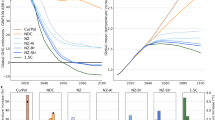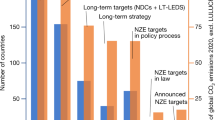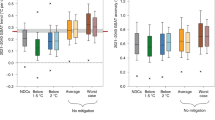Abstract
The new and updated emission reduction pledges submitted by countries ahead of the Twenty-Sixth Conference of Parties represent a meaningful strengthening of global ambition compared to the 2015 Paris pledges. Yet, limiting global warming below 1.5 °C this century will require countries to ratchet ambition for 2030 and beyond. Here, we explore a suite of emissions pathways to show that ratcheting near-term ambition through 2030 will be crucial to limiting peak temperature changes. Delaying ratcheting ambition to beyond 2030 could still deliver end-of-century temperature change of less than 1.5 °C but would result in higher temperature overshoot over many decades with the potential for adverse consequences. Ratcheting near-term ambition would also deliver benefits from enhanced non-CO2 mitigation and facilitate faster transitions to net-zero emissions systems in major economies.
This is a preview of subscription content, access via your institution
Access options
Access Nature and 54 other Nature Portfolio journals
Get Nature+, our best-value online-access subscription
$32.99 / 30 days
cancel any time
Subscribe to this journal
Receive 12 print issues and online access
$259.00 per year
only $21.58 per issue
Buy this article
- Purchase on SpringerLink
- Instant access to full article PDF
Prices may be subject to local taxes which are calculated during checkout





Similar content being viewed by others
Data availability
Country ratings from the CAT are publicly available at https://climateactiontracker.org/countries/. The latest (v.2020) Human Development Index is publicly available at https://hdr.undp.org/data-center/human-development-index#/indicies/HDI. The datasets generated during and analysed in the current study are available from a public repository (https://doi.org/10.5281/zenodo.7069063). Source data are provided with this paper.
Code availability
GCAM is an open-source community model available at https://github.com/JGCRI/gcam-core/releases. The version of GCAM and additional input files associated with this study are available at https://doi.org/10.5281/zenodo.7069066.
References
The Paris Agreement (UNFCCC, 2021); https://unfccc.int/process-and-meetings/the-paris-agreement/the-paris-agreement
Nationally Determined Contributions (NDCs) (UNFCCC, 2021); https://unfccc.int/process-and-meetings/the-paris-agreement/nationally-determined-contributions-ndcs/nationally-determined-contributions-ndcs#eq-1
Communication of Long-term Strategies (UNFCCC, 2021); https://unfccc.int/process/the-paris-agreement/long-term-strategies
CAT Net Zero Target Evaluations (Climate Action Tracker, 2021); https://climateactiontracker.org/global/cat-net-zero-target-evaluations/
Ou, Y. et al. Can updated climate pledges limit warming well below 2°C?. Science 374, 693–695 (2021).
Emissions Gap Report 2021: The Heat Is On—A World of Climate Promises Not Yet Delivered (United Nations Environment Programme, 2021).
Glasgow’s 2030 Credibility Gap: Net Zero’s Lip Service to Climate Action (Climate Action Tracker, 2021).
Grant, N. The Paris Agreement’s ratcheting mechanism needs strengthening 4-fold to keep 1.5 °C alive. Joule https://doi.org/10.1016/j.joule.2022.02.017 (2022).
Meinshausen, M. et al. Realization of Paris Agreement pledges may limit warming just below 2 °C. Nature 604, 304–309 (2022).
IPCC. Summary for Policymakers. In Climate Change 2022: Mitigation of Climate Change. Contribution of Working Group III to the Sixth Assessment Report of the Intergovernmental Panel on Climate Change, (eds Shukla, P.R. et al.) (Cambridge Univ. Press, 2022).
Lecocq, F. et al. in Climate Change 2022: Mitigation of Climate Change. Contribution of Working Group III to the Sixth Assessment Report of the Intergovernmental Panel on Climate Change (eds Shukla, P. R. et al.) Ch. 4, (Cambridge Univ. Press, 2022).
den Elzen, M. G. J. et al. Updated nationally determined contributions collectively raise ambition levels but need strengthening further to keep Paris goals within reach. Mitig. Adapt. Strateg. Glob. Change 27, 33 (2022).
The Glasgow Climate Pact (UNFCCC, 2021); https://unfccc.int/sites/default/files/resource/cop26_auv_2f_cover_decision.pdf
Calvin, K. et al. GCAM v5.1: representing the linkages between energy, water, land, climate, and economic systems. Geosci. Model Dev. 12, 677–698 (2019).
Hartin, C. A., Patel, P., Schwarber, A., Link, R. P. & Bond-Lamberty, B. P. A simple object-oriented and open-source model for scientific and policy analyses of the global climate system—Hector v1.0. Geosci. Model Dev. 8, 939–955 (2015).
Holz, C., Siegel, L. S., Johnston, E., Jones, A. P. & Sterman, J. Ratcheting ambition to limit warming to 1.5 °C–trade-offs between emission reductions and carbon dioxide removal. Environ. Res. Lett. 13, 064028 (2018).
Bharadwaj, B. & Brierley, C. Ratcheting up Ambition in Climate Policy (Environmental Change Research Centre, 2017); https://discovery.ucl.ac.uk/id/eprint/1541174/1/ecrc_report_182_Bharadwaj_Brierley.pdf
IPCC Special Report on Global Warming of 1.5 °C (eds Masson-Delmotte, V. et al.) (WMO, 2018).
Iyer, G. C. et al. The contribution of Paris to limit global warming to 2 °C. Environ. Res. Lett. 10, 125002 (2015).
Riahi, K. et al. in Climate Change 2022: Mitigation of Climate Change. Contribution of Working Group III to the Sixth Assessment Report of the Intergovernmental Panel on Climate Change (eds Shukla, P. R. et al.) Ch. 3, (Cambridge Univ. Press, 2022).
Countries (Climate Action Tracker, 2021); https://climateactiontracker.org/countries/
Rating System (Climate Action Tracker, 2021); https://climateactiontracker.org/countries/rating-system/
Riahi, K. et al. Cost and attainability of meeting stringent climate targets without overshoot. Nat. Clim. Change 11, 1063–1069 (2021).
van den Berg, N. J. et al. Implications of various effort-sharing approaches for national carbon budgets and emission pathways. Clim. Change 162, 1805–1822 (2019).
Rajamani, L. et al. National ‘fair shares’ in reducing greenhouse gas emissions within the principled framework of international environmental law. Clim. Policy 21, 983–1004 (2021).
Peng, W. et al. Climate policy models need to get real about people—here’s how. Nature 594, 174–176 (2021).
Hoegh-Guldberg, O. et al. in Global Warming of 1.5°C. An IPCC Special Report on the impacts of global warming of 1.5°C above pre-industrial levels and related global greenhouse gas emission pathways, in the context of strengthening the global response to the threat of climate change, sustainable development, and efforts to eradicate poverty (eds Masson-Delmotte, V. et al.) Ch. 3, (Cambridge Univ. Press, 2018).
Geden, O. & Löschel, A. Define limits for temperature overshoot targets. Nat. Geosci. 10, 881–882 (2017).
Drouet, L. et al. Net zero-emission pathways reduce the physical and economic risks of climate change. Nat. Clim. Change 11, 1070–1076 (2021).
Davis, S. J. et al. Net-zero emissions energy systems. Science https://doi.org/10.1126/science.aas9793 (2018).
Azevedo, I., Bataille, C., Bistline, J., Clarke, L. & Davis, S. Net-zero emissions energy systems: what we know and do not know. Energy Clim. Change https://doi.org/10.1016/j.egycc.2021.100049 (2021).
DeAngelo, J. et al. Energy systems in scenarios at net-zero CO2 emissions. Nat. Commun. 12, 6096 (2021).
Ou, Y. et al. Deep mitigation of CO2 and non-CO2 greenhouse gases toward 1.5 °C and 2 °C futures. Nat. Commun. 12, 6245 (2021).
The Global Methane Pledge (Climate & Clean Air Coalition, 2021); https://www.globalmethanepledge.org/
Herrero, M. et al. Greenhouse gas mitigation potentials in the livestock sector. Nat. Clim. Change 6, 452–461 (2016).
Clark, M. A. et al. Global food system emissions could preclude achieving the 1.5° and 2 °C climate change targets. Science 370, 705–708 (2020).
Harmsen, M. et al. The role of methane in future climate strategies: mitigation potentials and climate impacts. Clim. Change https://doi.org/10.1007/s10584-019-02437-2 (2019).
Iyer, G. et al. The role of carbon dioxide removal in net-zero emissions pledges. Energy Clim. Change https://doi.org/10.1016/j.egycc.2021.100043 (2021).
The Long-Term Strategy of the United States: Pathways to Net-Zero Greenhouse Gas Emissions by 2050 (United States Department of State, 2021); https://www.whitehouse.gov/wp-content/uploads/2021/10/US-Long-Term-Strategy.pdf
Fuhrman, J. et al. The role of direct air capture and negative emissions technologies in the shared socioeconomic pathways towards +1.5 °C and +2 °C futures. Environ. Res. Lett. https://doi.org/10.1088/1748-9326/ac2db0 (2021).
Roy, J. et al. in Global Warming of 1.5°C. An IPCC Special Report on the impacts of global warming of 1.5°C above pre-industrial levels and related global greenhouse gas emission pathways, in the context of strengthening the global response to the threat of climate change, sustainable development, and efforts to eradicate poverty (eds Masson-Delmotte, V. et al.) Ch. 5, (Cambridge Univ. Press, 2018).
Fuss, S. et al. Moving toward net-zero emissions requires new alliances for carbon dioxide removal. One Earth 3, 145–149 (2020).
Fuhrman, J. et al. Food–energy–water implications of negative emissions technologies in a +1.5 °C future. Nat. Clim. Change 10, 920–927 (2020).
Fuhrman, J., McJeon, H., Doney, S. C., Shobe, W. & Clarens, A. F. From zero to hero?: why integrated assessment modeling of negative emissions technologies is hard and how we can do better. Front. Clim. https://doi.org/10.3389/fclim.2019.00011 (2019).
Edmonds, J., Forrister, D., Clarke, L., de Clara, S. & Munnings, C. The Economic Potential of Article 6 of the Paris Agreement and Implementation Challenges (IETA, 2019); https://www.ieta.org/resources/International_WG/Article6/CLPC_A6%20report_no%20crops.pdf
Purohit, P., Borgford-Parnell, N., Klimont, Z. & Höglund-Isaksson, L. Achieving Paris climate goals calls for increasing ambition of the Kigali Amendment. Nat. Clim. Change 12, 339–342 (2022).
Iyer, G. et al. Diffusion of low-carbon technologies and the feasibility of long-term climate targets. Technol. Forecast. Soc. Change 90, 103–118 (2015).
Iyer, G. et al. Improved representation of investment decisions in assessments of CO2 mitigation. Nat. Clim. Change 5, 436–440 (2015).
Tong, D. et al. Geophysical constraints on the reliability of solar and wind power worldwide. Nat. Commun. 12, 6146 (2021).
Fuss, S. et al. Negative emissions—Part 2: Costs, potentials and side effects. Environ. Res. Lett. https://doi.org/10.1088/1748-9326/aabf9f (2018).
Brutschin, E. et al. A multidimensional feasibility evaluation of low-carbon scenarios. Environ. Res. Lett. https://doi.org/10.1088/1748-9326/abf0ce (2021).
IPCC Climate Change 2022: Mitigation of Climate Change (eds Shukla, P. R. et al.) (Cambridge Univ. Press, 2022).
Pebesma, E. Simple features for R: standardized support for spatial vector data. R. J. 10, 439–446 (2018).
Ou, Y. Source code for reproducing Fig5 (map) in Iyer & Ou, et al. 2022 Ratcheting of climate pledges needed to limit peak global warming. Zenodo https://doi.org/10.5281/zenodo.7082257 (2022).
Ou, Y. Source code and data for Ou et al. 2021 Updates to Paris climate pledges improve chances of limiting global warming to well below 2 °C. Zenodo https://doi.org/10.5281/zenodo.5821125 (2021).
Iyer, G. et al. Implications of sustainable development considerations for comparability across NDCs. Nat. Clim. Change 8, 124–129 (2018).
Fawcett, A. A. et al. Can Paris pledges avert severe climate change? Science 350, 1168–1169 (2015).
McJeon, H. et al. Limited impact on decadal-scale climate change from increased use of natural gas. Nature 514, 482–485 (2014).
Wise, M. et al. Implications of limiting CO2 concentrations for land use and energy. Science 324, 1183–1186 (2009).
Clarke, J. F. & Edmonds, J. Modelling energy technologies in a competitive market. Energy Econ. 15, 123–129 (1993).
McFadden, D. Econometric models for probabilistic choice among products. J. Bus. 53, S13–S29 (1980).
Boden, T. A., Marland, G. & Andres, R. J. Global, Regional, and National Fossil-Fuel CO2 Emissions (Carbon Dioxide Information Analysis Center, 2009).
World Energy Balances 2019 (International Energy Agency, 2019).
Wise, M., Calvin, K., Kyle, P., Luckow, P. & Edmonds, J. A. E. Economic and physical modeling of land use in Gcam 3.0 and an application to agricultural productivity, land, and terrestrial carbon. Clim. Change Econ. 05, 1450003 (2014).
Global Non-CO2 Greenhouse Gas Emission Projections & Mitigation 2015–2050 (United States Environmental Protection Agency, 2019).
O’Rourke, P. R. et al. CEDS v_2021_04_21 Release Emission Data (v_2021_02_05). Zenodo https://doi.org/10.5281/zenodo.4741285 (2021).
Real GDP growth (International Monetary Fund, 2021); https://www.imf.org/external/datamapper/NGDP_RPCH@WEO/OEMDC/ADVEC/WEOWORLD
Vimmerstedt et al. 2019 Annual Technology Baseline ATB Cost and Performance Data for Electricity Generation Technologies (National Renewable Energy Lab, 2019).
Jadun et al. Electrification Futures Study: End-use Electric Technology Cost and Performance Projections through 2050 (National Renewable Energy Lab, 2017).
Calvin, K. et al. Trade-offs of different land and bioenergy policies on the path to achieving climate targets. Clim. Change 123, 691–704 (2014).
Hartin, C. A., Bond-Lamberty, B., Patel, P. & Mundra, A. Ocean acidification over the next three centuries using a simple global climate carbon-cycle model: projections and sensitivities. Biogeosciences 13, 4329–4342 (2016).
XIE Zhenhua Explains 1+N Policy Framework for the Timeline and Roadmap of China’s Carbon Peak and Neutrality Goals (National Center for Climate Change Strategy and International Cooperation, accessed 4 March 2022); http://www.ncsc.org.cn/xwdt/gnxw/202107/t20210727_851433.shtml
Acknowledgements
The research described in this paper was conducted with support from the US EPA IAA DW-089-92460001 (G.I., Y.O., J.E., J.F., S.W. and H.M.). The views and opinions expressed in this paper are those of the authors alone and do not necessarily state or reflect those of the Environmental Protection Agency or the US Government and no official endorsement should be inferred.
Author information
Authors and Affiliations
Contributions
G.I. and Y.O. contributed equally to this study. G.I., Y.O., J.E., A.A.F., N.H. and H.M. designed the research. G.I. wrote the first draft of the paper. Y.O. conducted the simulations. G.I., Y.O., J.E., J.F., S.W. and H.M. contributed to the modelling tools. J.M. contributed to the writing of the paper. All authors contributed to writing the paper.
Corresponding author
Ethics declarations
Competing interests
The authors declare no competing interests.
Peer review
Peer review information
Nature Climate Change thanks Matthias Weitzel, Ioannis Dafnomilis and Kate Dooley for their contribution to the peer review of this work.
Additional information
Publisher’s note Springer Nature remains neutral with regard to jurisdictional claims in published maps and institutional affiliations.
Supplementary information
Supplementary Information
Supplementary Sections 1–3, Figs. 1–18 and Tables 1–8.
Source data
Source Data Fig. 1
Source data.
Source Data Fig. 2
Source data.
Source Data Fig. 3
Source data.
Source Data Fig. 4
Source data.
Source Data Fig. 5
Source data.
Rights and permissions
Springer Nature or its licensor (e.g. a society or other partner) holds exclusive rights to this article under a publishing agreement with the author(s) or other rightsholder(s); author self-archiving of the accepted manuscript version of this article is solely governed by the terms of such publishing agreement and applicable law.
About this article
Cite this article
Iyer, G., Ou, Y., Edmonds, J. et al. Ratcheting of climate pledges needed to limit peak global warming. Nat. Clim. Chang. 12, 1129–1135 (2022). https://doi.org/10.1038/s41558-022-01508-0
Received:
Accepted:
Published:
Issue date:
DOI: https://doi.org/10.1038/s41558-022-01508-0
This article is cited by
-
Navigating the black box of fair national emissions targets
Nature Climate Change (2025)
-
Global land system maps at 1 km resolution for 1.5 °C climate
Scientific Data (2025)
-
Targeted carbon dioxide removal measures are essential for the cost and energy transformation of the electricity sector by 2050
Communications Earth & Environment (2025)
-
Risks of relying on uncertain carbon dioxide removal in climate policy
Nature Communications (2025)
-
Land system changes of terrestrial tipping elements on Earth under global climate pledges: 2000–2100
Scientific Data (2025)



